LESS: Link Estimation with Sparse Sampling in Intertidal WSNs
Abstract
:1. Introduction
- We systematically investigate two real-world WSN systems in the intertidal area to reveal the network dynamics. To the best of our knowledge, this is the first measurement work in the real intertidal WSN systems.
- We analyze and verify the feasibility of compressive sensing and design the data and transform matrices to tailor CS for link quality reconstruction.
- We introduce LESS, a link estimation protocol for dynamic networks. We optimize the scheduling strategies and routing path update method with fine-grained system knowledge for various cases.
- We implement and evaluate LESS in the two real-world WSN systems as well as the trace-driven simulations. Exhaustive evaluation results demonstrate that can achieve high link estimation accuracy with limited overhead.
2. Related Work
2.1. Link Estimation Methods
2.2. Applications of Compressive Sensing
2.3. Marine WSNs
3. Problem Overview and Motivation
3.1. Network Dynamics in Intertidal WSN Systems
- Link quality change ratio: Nodes evaluate link quality between neighbors in each cycle, and we compare the link quality change between two continuous cycles. The link quality change ratio is defined as:where and represent the link quality between node a and node b at cycle t, and cycle .
- Topology change ratio: During one cycle, any occurrence of new links or disappearance of existing links is defined as a topology change. The topology change ratio is calculated as:
- Routing path change ratio: Similarly, any hop change along a routing path from a source to a destination is called a routing path change in one cycle. The routing path change ratio can be represented as:
3.2. Feasibility of Compressive Sensing
4. Utilization of Compressive Sensing
4.1. Prime of Compressive Sensing
4.2. Design of the Matrices
- How to represent the collected data in a proper format to fit for CS.
- What is the best transform matrix to make the data matrix sparse.
- How to further improve the reconstruction accuracy beyond compressive sensing by taking into account the additional data structure the systems share.
5. Design of Protocol
5.1. Protocol Overview
- : Update sampling rate. If any of the two conditions are satisfied, sampling rate needs to be increased: (1) over of nodes show deficiency in data collection (PDR decreases up to during the last 10 cycles); and/or (2) did not receive packets from over of nodes during the last 10 cycles. If the following conditions are satisfied, the sampling rate should be decreased: (1) the average PDR increases during the last 10 cycles; and (2) the average PDR stays in a considerable level (over ) for over 30 cycles. Note that the lowest sampling rate should equal to the initial sampling rate.
- : Update routing path. If the reconstructed link quality matrix produces different and new routing paths, the sink node informs relevant nodes to change their parent nodes.
5.2. Scheduling Algorithms
5.2.1. Random Sampling (RS)
| Algorithm 1 The Random Sampling (RS) Algorithm. |
| Input: Number of nodes , sampling rate s Output: The decision set D for the N nodes in time T 1: for and do 2: 3: end for 4: return D |
5.2.2. -Spatial Sampling (K-S)
| Algorithm 2 The -Spatial sampling (K-S) Algorithm. |
| Input: Number of nodes , , , new sampling rate Output: The decision set D for the N nodes in time T 1: for and do 2: if then 3: // the dense-deployed case. 4: else if then 5: // the sparse-deployed case. 6: end if 7: end for 8: return D |
5.2.3. -Temporal Sampling (K-T)
| Algorithm 3 The -Temporal sampling (K-T) Algorithm. |
| Input: System running period , , , new sampling rate Output: The decision set D for the N nodes in time T 1: for and do 2: if then 3: // the stationary phase. 4: else if then 5: // the dynamic case. 6: end if 7: end for 8: return D |
5.3. Routing Path Update
5.4. Discussion
6. System Implementation
6.1. Sensor Design
- Several existing methods keep radio transceivers above water using buoys while keeping sensors underwater. For example, SmartCoast [63] is a wireless sensor network for monitoring water quality utilizing such a method. However, these methods are supposed to operate in lakes, rivers, or estuaries, instead of in intertidal zones where strong waves appear constantly. The strong waves may destroy the cables between the above-water transceivers and the under-water sensors. Besides, buoys will run aground during low-tide periods, and there are high risks that buoys will not float up successfully when high tide comes.
- Intertidal WSNs are designed for monitoring the environmental parameters such as temperature precisely. As a result, sensors should be as close to the creature’s microhabitat as possible, e.g., attached to the rock substrata wherein mussels live. In this condition, connecting sensor nodes to transceivers with wobbly cables will destroy the natural environments of the creatures. Note that to minimize the impact of sensor nodes in our system, we specially designed the sensor nodes as shown in Figure 9c.
- The spots where mussels stay may be far away from the seashore and therefore the water depth is unpredictable. For instance, we observed the water depth in the Zhoushan system can be 5 m. In this case, placing a transmission device on a pole (higher than the high tide level) is impractical.
- Cables may be cut off by creatures such as fiddler crabs in intertidal areas. In addition, human beings are also threats to the cables unless people are forbidden to go into those areas.
6.2. Network Architecture
6.3. Packet Format
6.4. Network Deployment
7. Performance Evaluation
7.1. Performance Metrics
7.2. Evaluation in Real Systems
7.2.1. Comparison with Interpolation
7.2.2. Link Quality Reconstruction
7.2.3. Routing Path Reconstruction
7.2.4. Topology Reconstruction
7.2.5. Evaluation of Energy Consumption
7.2.6. Time Complexity Analysis
7.3. Large-Scale Trace-Driven Simulations
7.3.1. Settings
7.3.2. Results
7.3.3. The Comparison of Simulation Result and Experiment Result
8. Conclusions
Acknowledgments
Author Contributions
Conflicts of Interest
References
- Denny, M.W. Wave forces on intertidal organisms: A case study. Limnol. Oceanogr. 1985, 30, 1171–1187. [Google Scholar]
- Fonseca, R.; Gnawali, O.; Jamieson, K.; Levis, P. Four-Bit Wireless Link Estimation. In Proceedings of the ACM HotNets, Atlanta, GA, USA, 14–15 November 2007. [Google Scholar]
- Kim, K.H.; Shin, K.G. On accurate measurement of link quality in multi-hop wireless mesh networks. In Proceedings of the 12th Annual International Conference on Mobile Computing and Networking, Los Angeles, CA, USA, 23–29 September 2006. [Google Scholar]
- Davenport, M.A.; Laska, J.N.; Treichler, J.R.; Baraniuk, R.G. The pros and cons of compressive sensing for wideband signal acquisition: Noise folding versus dynamic range. IEEE Trans. Signal Proc. 2012, 60, 4628–4642. [Google Scholar]
- Baccour, N.; Koubâa, A.; Mottola, L.; Zúñiga, M.A.; Youssef, H.; Boano, C.A.; Alves, M. Radio link quality estimation in wireless sensor networks: A survey. ACM Trans. Sens. Netw. 2012, 8, 34. [Google Scholar] [CrossRef] [Green Version]
- Tang, S.; Zhang, B.; Watanabe, M.; Tanaka, S. A link heterogeneity-aware on-demand routing (LHAOR) protocol utilizing local update and RSSI information. IEICE Trans. Commun. 2005, 88, 3588–3597. [Google Scholar] [CrossRef]
- HUO, G.C.; WANG, X.D. An opportunistic routing for mobile wireless sensor networks based on RSSI. Acta Electron. Sin. 2009, 3, 034. [Google Scholar]
- Awang, A.; Lagrange, X.; Ros, D. RSSI-Based Forwarding for Multihop Wireless Sensor Networks; Springer: Eunice, LA, USA, 2009; pp. 138–147. [Google Scholar]
- Yan, C.; Hu, J.; Shen, L.; Song, T. RPLRE: A routing protocol based on LQI and residual energy for wireless sensor networks. In Proceedings of the 2009 1st International Conference on Information Science and Engineering (ICISE), Nanjing, China, 26–28 December 2009; pp. 2714–2717. [Google Scholar]
- Liang, J.J.; Yuan, Z.W.; Lei, J.J.; Kwon, G.I. Reliable routing algorithm on wireless sensor network. In Proceedings of the 12th International Conference on Advanced Communication Technology (ICACT), Phoenix Park, Korea, 7–10 February 2010; Volume 1, pp. 47–51. [Google Scholar]
- Gungor, V.C.; Sastry, C.; Song, Z.; Integlia, R. Resource-aware and link quality based routing metric for wireless sensor and actor networks. In Proceedings of the ICC’07 IEEE International Conference on Communications, Glasgow, UK, 24–28 June 2007; pp. 3364–3369. [Google Scholar]
- Ganesh, S.; Amutha, R. Efficient and secure routing protocol for wireless sensor networks through SNR based dynamic clustering mechanisms. J. Commun. Netw. 2013, 15, 422–429. [Google Scholar]
- Ma, Y. Improving wireless link delivery ratio classification with packet snr. In Proceedings of the 2005 IEEE International Conference on Electro Information Technology, Lincoln, NE, USA, 22–25 May 2005. [Google Scholar]
- Chen, D.; Haenggi, M.; Laneman, J.N. Distributed spectrum-efficient routing algorithms in wireless networks. IEEE Trans.Wirel. Commun. 2008, 7, 5297–5305. [Google Scholar] [CrossRef]
- Srinivasan, K.; Dutta, P.; Tavakoli, A.; Levis, P. Understanding the causes of packet delivery success and failure in dense wireless sensor networks. In Proceedings of the 4th International Conference on Embedded Networked Sensor Systems, Boulder, CO, USA, 31 October–3 November 2006. [Google Scholar]
- Seada, K.; Zuniga, M.; Helmy, A.; Krishnamachari, B. Energy-efficient forwarding strategies for geographic routing in lossy wireless sensor networks. In Proceedings of the 2nd International Conference on Embedded Networked Sensor Systems, Baltimore, MD, USA, 3–5 November 2004; pp. 108–121. [Google Scholar]
- Ahmed, A.A.; Latiff, L.A.; Sarijari, M.; Fisal, N. Real-time routing in wireless sensor networks. In Proceedings of the 28th International Conference on Distributed Computing Systems Workshops (ICDCS’08), Beijing, China, 17–20 June 2008; pp. 114–119. [Google Scholar]
- De Couto, D.S.; Aguayo, D.; Bicket, J.; Morris, R. A high-throughput path metric for multi-hop wireless routing. In Proceedings of the ACM MobiCom, San Diego, CA, USA, 14–19 September 2003. [Google Scholar]
- Rozner, E.; Seshadri, J.; Mehta, Y.; Qiu, L. SOAR: Simple opportunistic adaptive routing protocol for wireless mesh networks. IEEE Trans. Mob. Comput. 2009, 8, 1622–1635. [Google Scholar]
- Biswas, S.; Morris, R. ExOR: Opportunistic multi-hop routing for wireless networks. ACM SIGCOMM Comput. Commun. Rev. 2005, 35, 133–144. [Google Scholar] [CrossRef]
- Zhang, H.; Arora, A.; Sinha, P. Learn on the Fly: Data-Driven Link Estimation and Routing in Sensor Network Backbones. In Proceedings of the 25th IEEE International Conference on Computer Communications (INFOCOM), Barcelona, Spain, 23–29 April 2006. [Google Scholar]
- Luo, C.; Wu, F.; Sun, J.; Chen, C.W. Compressive data gathering for large-scale wireless sensor networks. Proceedings of 15th Annual International Conference on Mobile Computing and Networking (MobiCom ’09), Beijing, China, 20–25 September 2009. [Google Scholar]
- Liu, X.Y.; Zhu, Y.; Kong, L.; Liu, C.; Gu, Y.; Vasilakos, A.V.; Wu, M.Y. CDC: Compressive data collection for wireless sensor networks. IEEE Trans. Parallel Distrib. Syst. 2015, 26, 2188–2197. [Google Scholar] [CrossRef]
- Liu, G.; Tan, R.; Zhou, R.; Xing, G.; Song, W.Z.; Lees, J.M. Volcanic earthquake timing using wireless sensor networks. In Proceedings of the 2013 ACM/IEEE International Conference on Information Processing in Sensor Networks (IPSN), Philadelphia, PA, USA, 8–11 April 2013. [Google Scholar]
- Liu, Z.; Li, Z.; Li, M.; Xing, W.; Lu, D. Path reconstruction in dynamic wireless sensor networks using compressive sensing. In Proceedings of the ACM MobiHoc, Philadelphia, PA, USA, 11–14 August 2014. [Google Scholar]
- Karakus, C.; Gurbuz, A.C.; Tavli, B. Analysis of energy efficiency of compressive sensing in wireless sensor networks. IEEE Sens. J. 2013, 13, 1999–2008. [Google Scholar] [CrossRef]
- Liu, R.; Liang, Y.; Zhong, X. Monitoring Routing Topology in Dynamic Wireless Sensor Network Systems. In Proceedings of the 2015 IEEE 23rd International Conference on Network Protocols (ICNP), San Francisco, CA, USA, 10–13 November 2015. [Google Scholar]
- Liu, K.; Yang, Z.; Li, M.; Guo, Z.; Guo, Y.; Hong, F.; Yang, X.; He, Y.; Feng, Y.; Liu, Y. Oceansense: Monitoring the sea with wireless sensor networks. ACM SIGMOBILE Mob. Comput. Commun. Rev. 2010, 14, 7–9. [Google Scholar] [CrossRef]
- Climent, S.; Sanchez, A.; Capella, J.V.; Meratnia, N.; Serrano, J.J. Underwater acoustic wireless sensor networks: Advances and future trends in physical, MAC and routing layers. Sensors 2014, 14, 795–833. [Google Scholar] [PubMed]
- Trevathan, J.; Johnstone, R.; Chiffings, T.; Atkinson, I.; Bergmann, N.; Read, W.; Theiss, S.; Myers, T.; Stevens, T. SEMAT—The next generation of inexpensive marine environmental monitoring and measurement systems. Sensors 2012, 12, 9711–9748. [Google Scholar] [PubMed]
- Safaric, S.; Malaric, K. ZigBee wireless standard. In Proceedings of the 48th International Symposium ELMAR-2006 Focused on Multimedia Signal Processing and Communications, Zadar, Croatia, 7–10 June 2006; pp. 259–262. [Google Scholar]
- Vangelista, L.; Zanella, A.; Zorzi, M. Long-range IoT technologies: The dawn of LoRa™. In Future Access Enablers of Ubiquitous and Intelligent Infrastructures; Springer: Basel, Switzerland, 2015; pp. 51–58. [Google Scholar]
- Ratasuk, R.; Vejlgaard, B.; Mangalvedhe, N.; Ghosh, A. NB-IoT system for M2M communication. In Proceedings of the 2016 IEEE Wireless Communications and Networking Conference (WCNC), Doha, Qatar, 3–6 April 2016; pp. 1–5. [Google Scholar]
- Liu, Y.; He, Y.; Li, M.; Wang, J.; Liu, K.; Li, X. Does wireless sensor network scale? A measurement study on GreenOrbs. IEEE Trans. Parallel Distrib. Syst. 2013, 24, 1983–1993. [Google Scholar]
- Wu, X.; Liu, M. In-situ soil moisture sensing: Measurement scheduling and estimation using compressive sensing. In Proceedings of the 2012 ACM/IEEE 11th International Conference on Information Processing in Sensor Networks (IPSN), Beijing, China, 16–20 April 2012. [Google Scholar]
- Song, W.Z.; Huang, R.; Xu, M.; Ma, A.; Shirazi, B.; LaHusen, R. Air-dropped sensor network for real-time high-fidelity volcano monitoring. In Proceedings of the MobiSys ’09 7th International Conference on Mobile Systems, Applications, and Services, Kraków, Poland, 22–25 June 2009. [Google Scholar]
- Gnawali, O.; Fonseca, R.; Jamieson, K.; Moss, D.; Levis, P. Collection tree protocol. In Proceedings of the SenSys ’09 7th ACM Conference on Embedded Networked Sensor Systems, Berkeley, CA, USA, 4–6 November 2009. [Google Scholar]
- Zhao, Z.; Dong, W.; Guan, G.; Bu, J.; Gu, T.; Chen, C. Modeling link correlation in low-power wireless networks. In Proceedings of the 2015 IEEE Conference on Computer Communications (INFOCOM), Kowloon, Hong Kong, China, 26 April–1 May 2015. [Google Scholar]
- Ji, X.; He, Y.; Wang, J.; Wu, K.; Yi, K.; Liu, Y. Voice over the dins: Improving wireless channel utilization with collision tolerance. In Proceedings of the 2013 21st IEEE International Conference on Network Protocols (ICNP), Goettingen, Germany, 7–10 October 2013. [Google Scholar]
- Levis, P.; Patel, N.; Culler, D.; Shenker, S. Trickle: A Self-Regulating Algorithm for Code Propagation and Maintenance in Wireless Sensor Networks. In Proceedings of the Symposium on Networked Systems Design and Implementation, San Diego, CA, USA, 29–31 March 2004; pp. 15–28. [Google Scholar]
- Candes, E.; Tao, T. Near optimal signal recovery from random projections: Universal encoding strategies? IEEE Trans. Inf. Theory 2006, 52, 5406–5425. [Google Scholar] [CrossRef]
- Rank (Linear Algebra). Available online: https://en.wikipedia.org/wiki/Rank_(linear_algebra) (accessed on 28 February 2018).
- Negahban, S.; Wainwright, M.J. Estimation of (near) low-rank matrices with noise and high-dimensional scaling. Ann. Stat. 2011, 39, 1069–1097. [Google Scholar] [CrossRef]
- Chen, Y.C.; Qiu, L.; Zhang, Y.; Xue, G.; Hu, Z. Robust Network Compressive Sensing. In Proceedings of the MobiCom ’14 20th Annual International Conference on Mobile Computing and Networking, Maui, HI, USA, 7–11 September 2014. [Google Scholar]
- Wold, S.; Esbensen, K.; Geladi, P. Principal component analysis. Chemom. Intell. Lab. Syst. 1987, 2, 37–52. [Google Scholar] [CrossRef]
- Kong, L.; Xia, M.; Liu, X.Y.; Chen, G.; Gu, Y.; Wu, M.Y.; Liu, X. Data loss and reconstruction in wireless sensor networks. IEEE Trans. Parallel Distrib. Syst. 2014, 25, 2818–2828. [Google Scholar]
- Feng, C.; Au, W.S.A.; Valaee, S.; Tan, Z. Received-signal-strength-based indoor positioning using compressive sensing. IEEE Trans. Mob. Comput. 2012, 11, 1983–1993. [Google Scholar] [CrossRef]
- Donoho, D.L. Compressed sensing. IEEE Trans. Inf. Theory 2006, 52, 1289–1306. [Google Scholar] [CrossRef]
- Zhang, Y.; Roughan, M.; Willinger, W.; Qiu, L. Spatio-Temporal Compressive Sensing and Internet Traffic Matrices. IEEE/ACM Trans. Netw. 2009, 20, 662–676. [Google Scholar]
- He, Y.; Wang, D.; Zhu, M. Sparse Representation over Overcomplete Dictionary Based on Bayesian Nonparametric Approximation. Energy Procedia 2011, 13, 2086–2093. [Google Scholar]
- Duarte, M.F.; Wakin, M.B.; Baraniuk, R.G. Wavelet-Domain Compressive Signal Reconstruction Using a Hidden Markov Tree Model. In Proceedings of the IEEE International Conference on Acoustics, Speech and Signal Processing (ICASSP 2008), Las Vegas, NV, USA, 31 March–4 April 2008. [Google Scholar]
- Bhatnagar, D.; Budhiraja, S. Article: Image Compression using DCT based Compressive Sensing and Vector Quantization. Int. J. Comput. Appl. 2012, 50, 34–38. [Google Scholar]
- Candès, E.J. The restricted isometry property and its implications for compressed sensing. Comptes Rendus Mathematique 2008, 346, 589–592. [Google Scholar]
- Toeplitz. Available online: https://en.wikipedia.org/wiki/Toeplitz_matrix (accessed on 28 February 2018).
- Sun, Y.; Gurewitz, O.; Du, S.; Tang, L.; Johnson, D.B. ADB: An efficient multihop broadcast protocol based on asynchronous duty-cycling in wireless sensor networks. In Proceedings of the 7th ACM Conference on Embedded Networked Sensor Systems, Berkeley, CA, USA, 4–6 November 2009; pp. 43–56. [Google Scholar]
- Durresi, A.; Paruchuri, V.K.; Iyengar, S.S.; Kannan, R. Optimized broadcast protocol for sensor networks. IEEE Trans. Comput. 2005, 54, 1013–1024. [Google Scholar]
- Skiena, S. Dijkstra’s algorithm. Implementing Discrete Mathematics: Combinatorics and Graph Theory with Mathematica; Addison-Wesley: Reading, UK, 1990; pp. 225–227. [Google Scholar]
- Dai, Y.S.; Levitin, G.; Trivedi, K.S. Performance and reliability of tree-structured grid services considering data dependence and failure correlation. IEEE Trans. Comput. 2007, 56, 925–936. [Google Scholar]
- Liang, C.J.M.; Musăloiu-e, R.; Terzis, A. Typhoon: A reliable data dissemination protocol for wireless sensor networks. In Wireless Sensor Networks; Springer: Berlin, Heidelberg, 2008. [Google Scholar]
- Wu, Y.; Chou, P.A.; Kung, S.Y. Information Exchange in Wireless Networks with Network Coding and Physical-Layer Broadcast; Technical report, MSR-TR-2004-78; Microsoft Research Lab: Redmond, WA, USA, 1 August 2004. [Google Scholar]
- Mao, X.; Miao, X.; He, Y.; Li, X.Y.; Liu, Y. CitySee: Urban CO2 monitoring with sensors. In Proceedings of the IEEE INFOCOM, Orlando, FL, USA, 25–30 March 2012. [Google Scholar]
- Guglielmo, D.D.; Brienza, S.; Anastasi, G. IEEE 802.15.4e: A survey. Comput. Commun. 2016, 88, 1–24. [Google Scholar] [CrossRef]
- O’Flynn, B.; Martinezcatala, R.; Harte, S.; O’Mathuna, C.; Cleary, J.; Slater, C.; Regan, F.; Diamond, D.; Murphy, H. SmartCoast: A Wireless Sensor Network for Water Quality Monitoring. In Proceedings of the IEEE Conference on Local Computer Networks, Dublin, Ireland, 15–18 October 2007; pp. 815–816. [Google Scholar]
- STM21L151. Available online: www.st.com/content/st_com/en/products/microcontrollers/stm32-32-bit-arm-cortex-mcus/stm32-ultra-low-power-mcus/stm32l1-series/stm32l151-152/stm32l151c8.html (accessed on 28 February 2018).
- AT86RF212. Available online: http://www.microchip.com/wwwproducts/en/at86rf212b (accessed on 28 February 2018).
- TMP102. Available online: www.ti.com/lit/ds/symlink/tmp102.pdf (accessed on 28 February 2018).
- National Oceanic and Atmospheric Administration. 2016. Available online: http://www.noaa.gov (accessed on 28 February 2018).




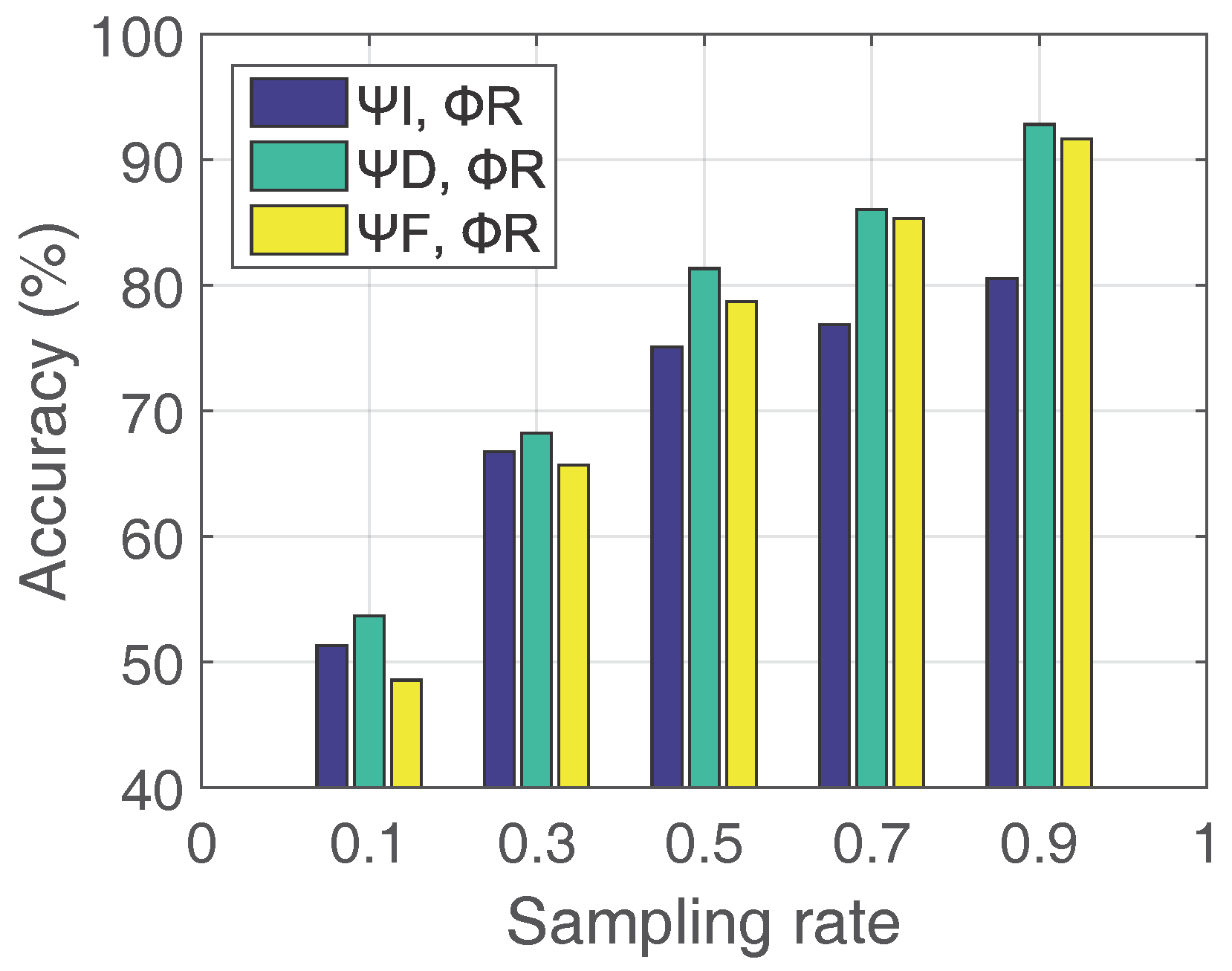
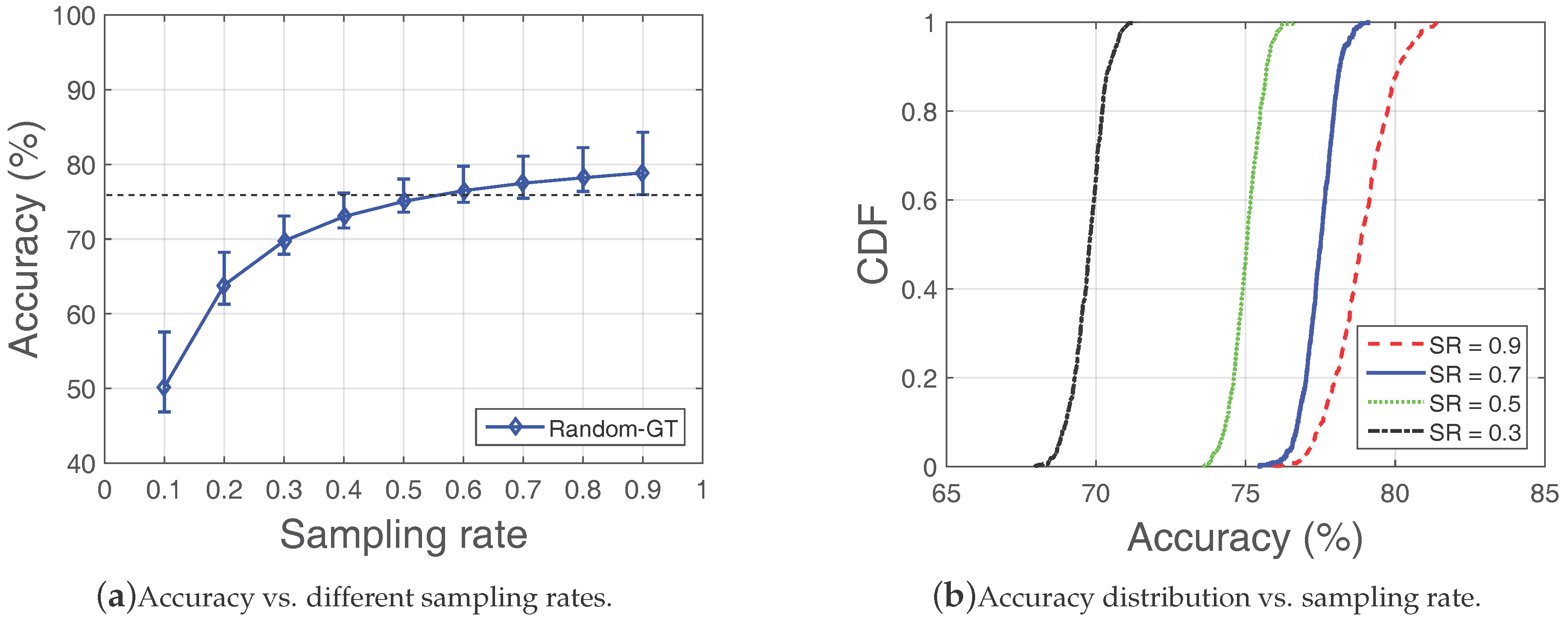

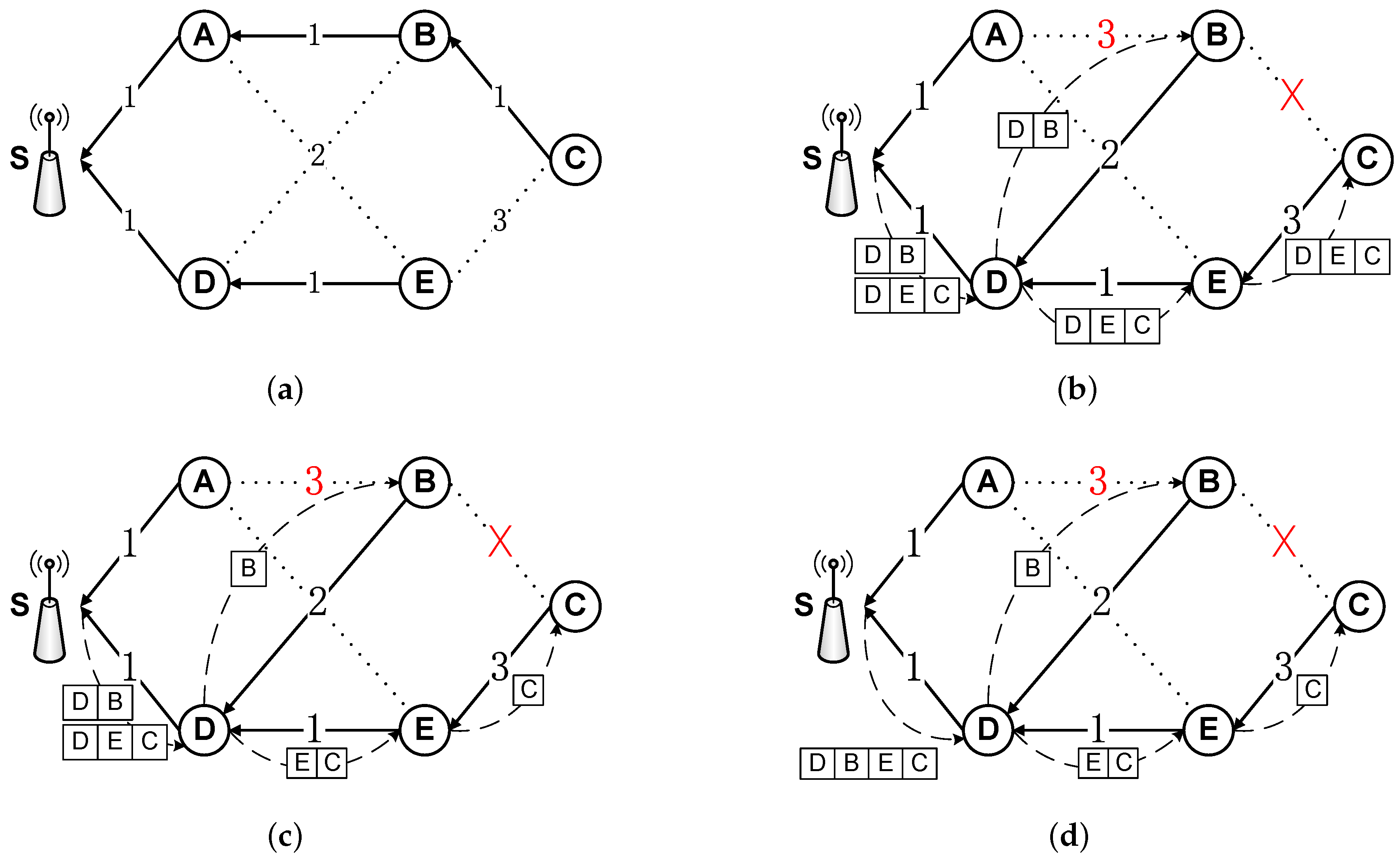
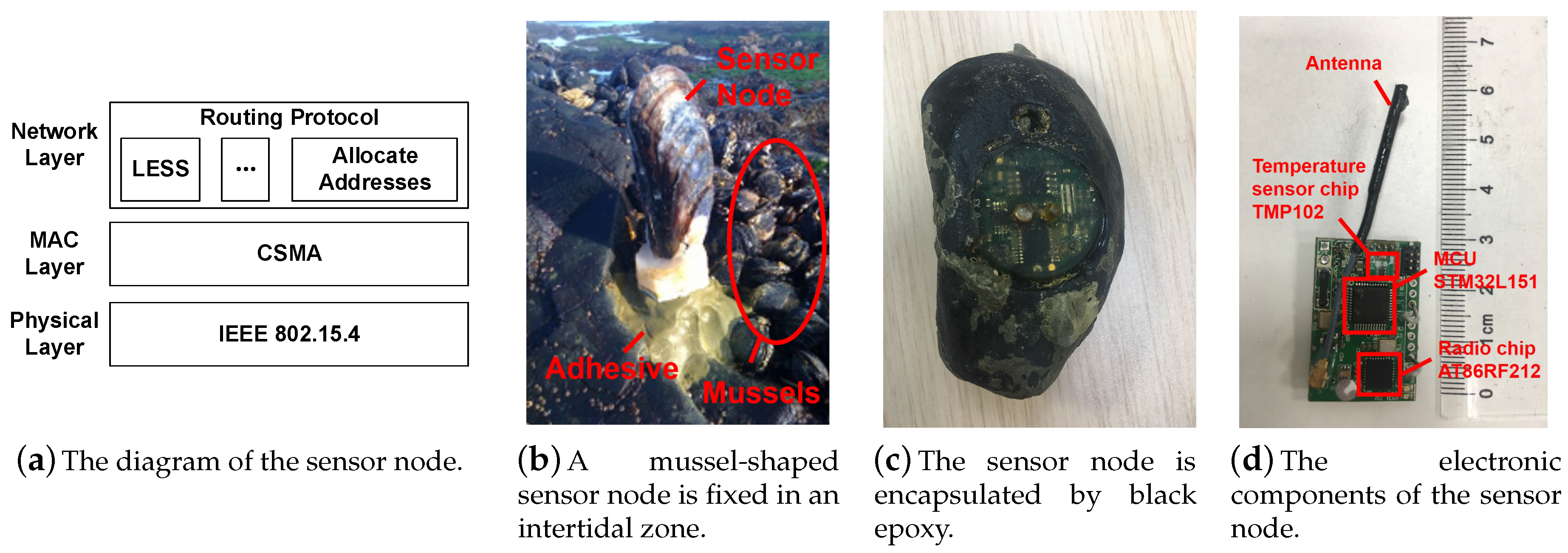
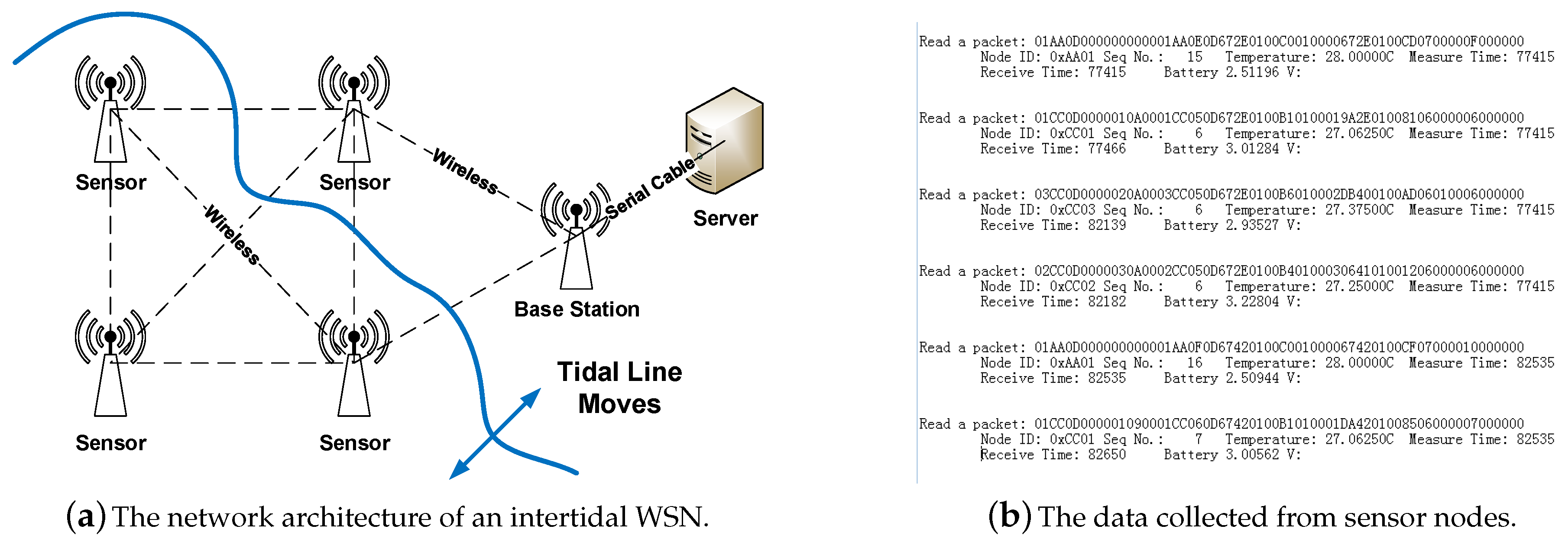
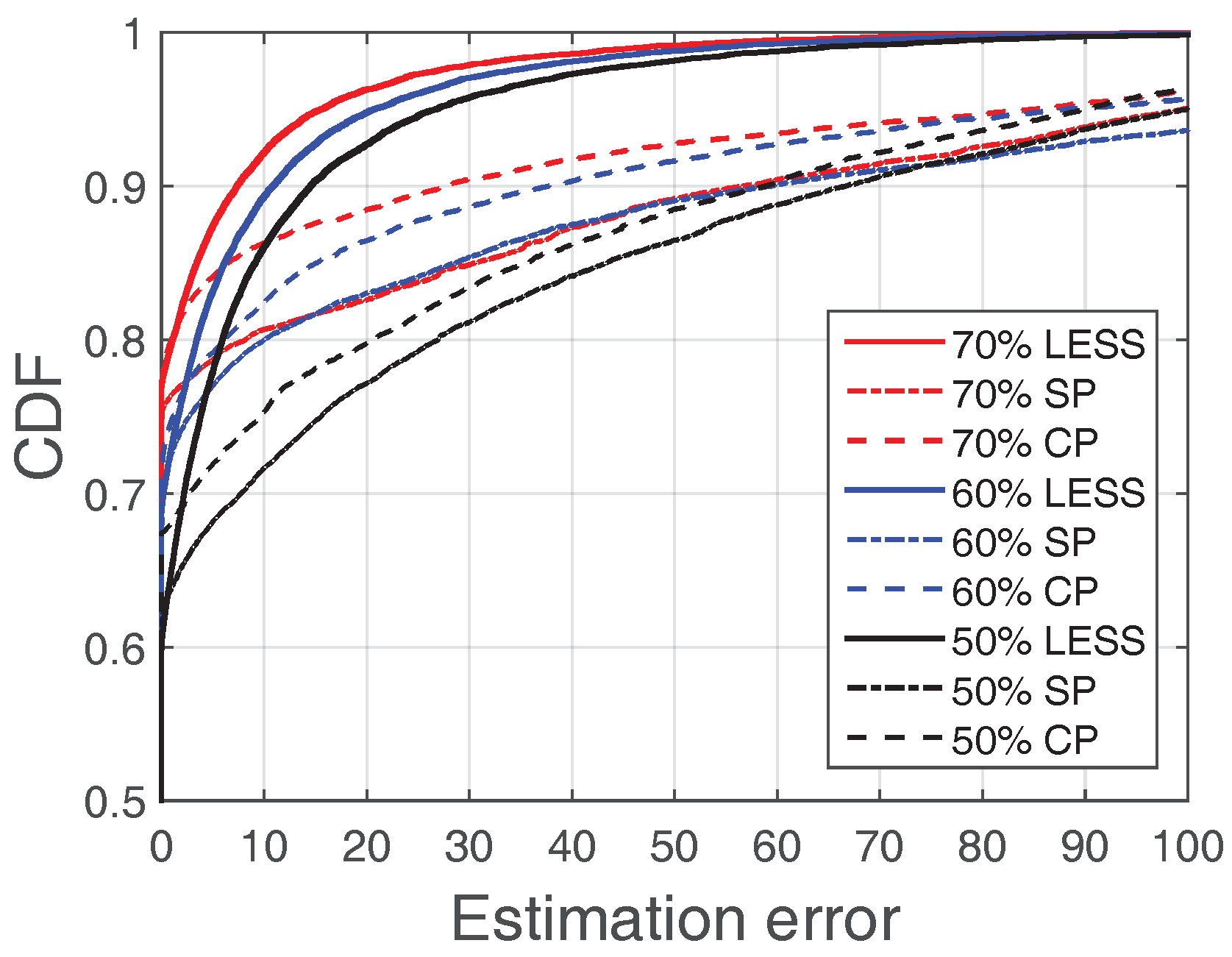

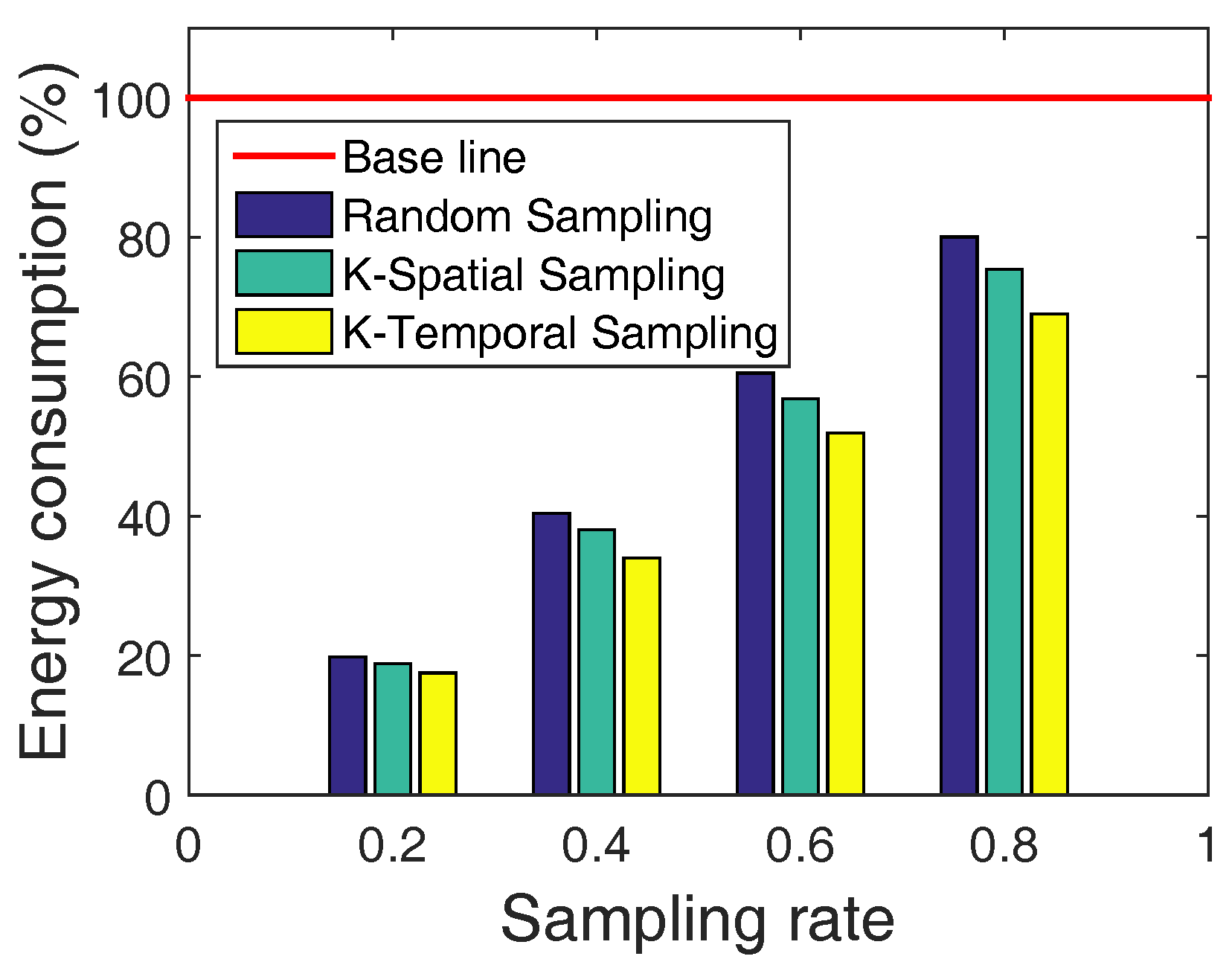
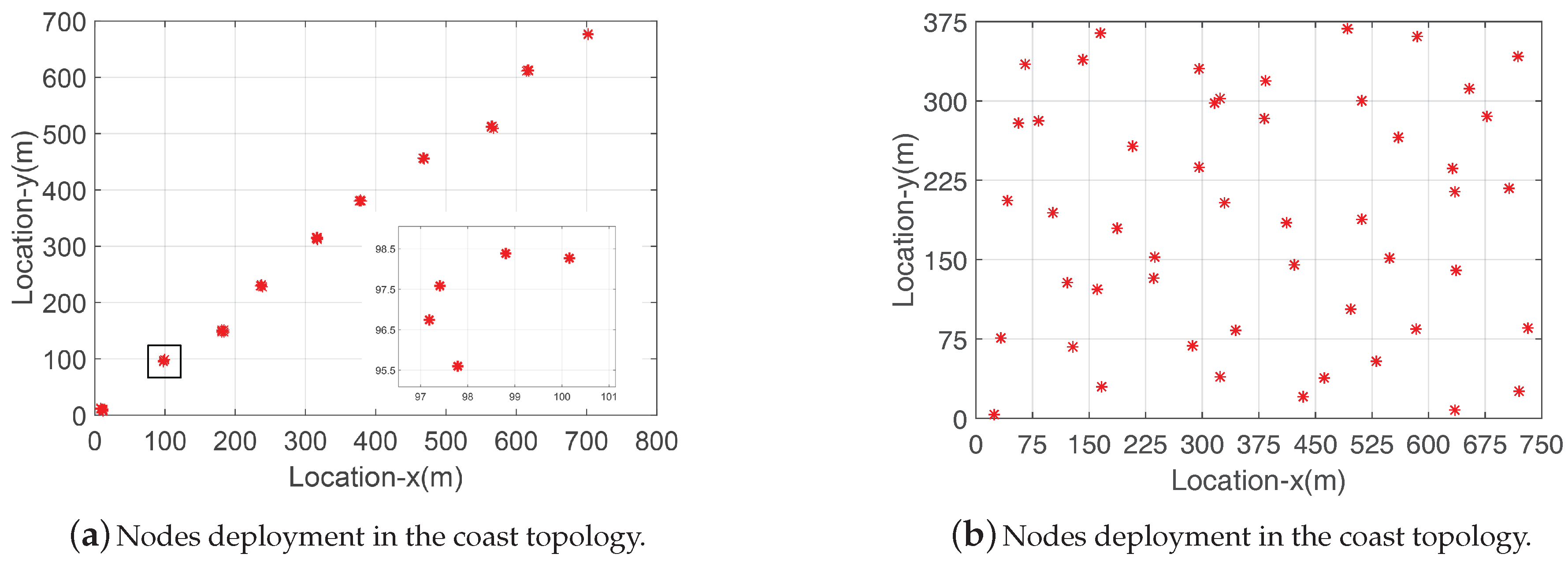


| Key Node Info. | 0% | 25% | 50% | 75% | 100% |
|---|---|---|---|---|---|
| Average Error | 61.8% | 49.5% | 46.1% | 28.6% | 22.5% |
| WSNs | The System Knowledge K |
|---|---|
| Intertidal WSN | Tide schedule, the location of nodes |
| GreenOrbs [34] | Weather, the location of nodes |
| SoilScape [35] | Weather, moisture, depth of nodes |
| OASIS [36] | Temperature, the location of nodes |
| i, N | N is the set of nodes, and . |
| t, T | T is the running period, and . |
| The system knowledge. In the intertidal zone, is reflected in . | |
| s | Sampling rate of the system |
| User-defined weight coefficient of sampling rates in systems with spatial characteristics. | |
| User-defined weight coefficient of sampling rates in systems with temporal characteristics. . | |
| D is the decision matrix; node i will be sampled at time t if . |
| Topology | Coast topology and uniform topology |
| Network size | 50 nodes in each network |
| Communication range | 150 m |
| Nodes altitude distribution | [2,3], [2,4] or [2,5] (unit: meter) |
| Sampling rate | 0.2, 0.3, 0.4, 0.5, 0.6, 0.7, 0.8, 0.9 |
© 2018 by the authors. Licensee MDPI, Basel, Switzerland. This article is an open access article distributed under the terms and conditions of the Creative Commons Attribution (CC BY) license (http://creativecommons.org/licenses/by/4.0/).
Share and Cite
Zhou, X.; Ji, X.; Chen, Y.-c.; Li, X.; Xu, W. LESS: Link Estimation with Sparse Sampling in Intertidal WSNs. Sensors 2018, 18, 747. https://doi.org/10.3390/s18030747
Zhou X, Ji X, Chen Y-c, Li X, Xu W. LESS: Link Estimation with Sparse Sampling in Intertidal WSNs. Sensors. 2018; 18(3):747. https://doi.org/10.3390/s18030747
Chicago/Turabian StyleZhou, Xinyan, Xiaoyu Ji, Yi-chao Chen, Xiaopeng Li, and Wenyuan Xu. 2018. "LESS: Link Estimation with Sparse Sampling in Intertidal WSNs" Sensors 18, no. 3: 747. https://doi.org/10.3390/s18030747





